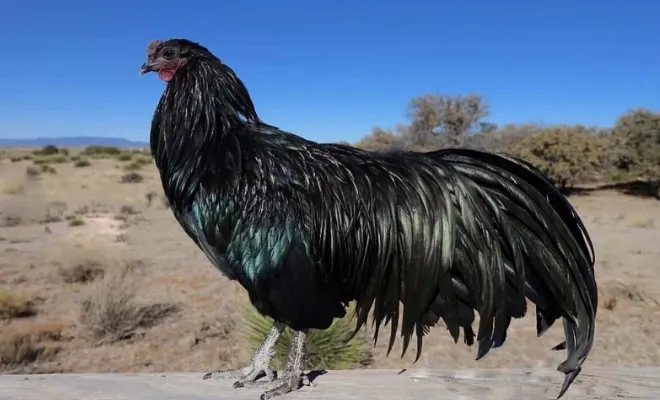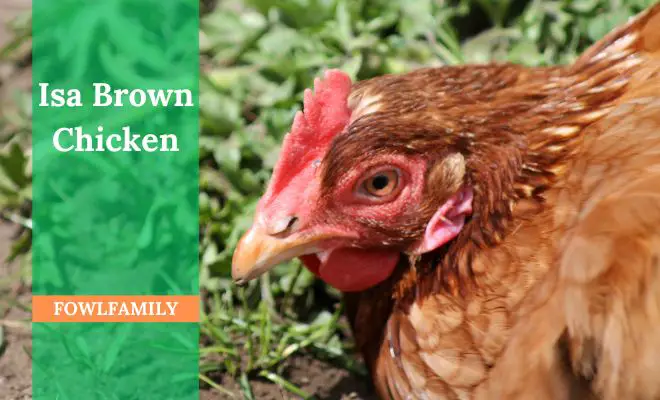Japan’s National Treasure: A Look at Shamo Chickens!

Shamo chickens are a distinctive breed, a special bird from Japan. Standing tall and proud, these muscular birds boast a legacy as fierce fighters, though today they grace showrooms and coops with their unique elegance.
Bred from Thai fighting stock centuries ago, Shamos has been sculpted into seven distinct breeds. While some might see their fighting past as intimidating, Shamos are devoted mothers and good egg layers, as well. But don’t be fooled by their regal appearance! They are active birds who need space to roam and have a personality to carry.
So, don’t think they’re just ordinary birds! If you want a chicken that’s different from the usual, consider getting a Shamo! However, let’s learn more about them.
Table of Contents
Shamo Chickens – A Short Profile

Statuesque warrior with a gentle side, Shamo chickens are far from your average backyard bird. If you are curious to know about Shamo chickens, check this profile to get them.
| Feature | Description |
|---|---|
| Origin | Japan, descended from Thai fighting stock |
| Breeds | Seven distinct breeds |
| Colors | White, black, wheaten, reddish-brown, and more |
| Temperament | Gentle and docile, good mothers |
| Egg laying | Good egg production for their size |
| Activity level | Active, require space to roam |
| Potential for aggression | Roosters may be territorial towards other chickens |
| Lifespan | 6-8 years |
| Some breeds are rare than others | Adaptable to most climates with proper care |
| Rarity | Some breeds more rare than others |
| Legality | Ownership may be restricted in some areas |
What Are the History And Location Of the Shamo Chicken?
The Shamo chicken’s story begins centuries ago in Thailand. It’s where they were prized for their strength and agility in cockfighting.
They are known for their unique “naked heel” style. Their name, “Shamo,” even reflects their origin, being a Japanese interpretation of “Siam,” the former name for Thailand.
Migration and Transformation
Around the early 1600s, these feathered warriors made their way to Japan. It’s when they became an integral part of the samurai culture.
Selective breeding over generations transformed them into distinct breeds, each with its own weight class and characteristics. They were no longer just fighting machines, but also symbols of courage and power.
Beyond the Battlefield
Cockfighting eventually declined in popularity, and Shamos began to be recognized for their majestic appearance. Today, they are primarily bred for exhibition and ornamental purposes. So, they are captivating audiences with their upright stance, muscular build, and diverse plumage.
A Global Presence
Shamos are most associated with Japan. But they can be found in various countries around the world, including the United States, Europe, and Australia.
The first time a Shamo chicken was seen outside of Japan was noted by a German poultry writer named Bruno Duringen.
He said that in March 1884, the Countess of Ulm-Erbach brought the first pairs of Shamos to Germany. Then, in 1953, another group of Shamos was brought from the Tokyo Zoo to the Hagenback Zoo.
Dedicated breeders continue to preserve this unique breed. It helps their legacy lives on for generations to come.
Physical Appearance of the Shamo Chicken

Shamo chickens are really special, standing out with their unique looks. Let’s learn about what makes male and female Shamos different:
Male Shamos
- Shamo roosters are tall and look confident.
- They’re much bigger than hens, with some types weighing as much as 11 lbs!
- These roosters are like athletes, with strong muscles. It’s especially in their thighs.
- Their feathers are packed tightly. But they don’t cover their whole body. So, you see them showing bare skin on their legs, neck, and chest.
- Shamo roosters come in lots of colors, like black, white, wheaten, and reddish-brown.
Female Shamos
- Shamo hens might not be as big as roosters.
- Like the roosters, hens have tight feathers but don’t cover everything.
- Shamo hens are gentle and great at taking care of their chicks.
Shared Traits
- Both males and females have small, pea-shaped combs on their heads.
- Female Shamos have the same colorful feathers as males, making them pretty.
- Their wattles are small too, making them look sleek.
- Both sexes have light-colored eyes.
- Their beaks and legs are usually bright yellow.
Have a look at this unique chicken breed!
Different Types of Shamo Chicken: What are the 7 breeds of Shamo?
While researching, I found various Shamo chicken breeds. Choosing the right Shamo breed depends on your experience, available space, and desired characteristics. Let’s learn about them at the table!
| Breed Name | Weight (Roosters) | Weight (Hens) | Notes |
|---|---|---|---|
| O-Shamo | 8.8 lbs (4 kg) | 6.6 lbs (3 kg) | Largest Shamo breed, known for its imposing presence. |
| Chu-Shamo | 6.6 lbs (3 kg) | 4.4 lbs (2 kg) | Medium-sized Shamo, popular for its athleticism and agility. |
| Ko-Shamo | 4.4 lbs (2 kg) | 3.3 lbs (1.5 kg) | Smallest Shamo breed, known for its delicate features and gentle nature. |
| Mini-Shamo | 2.2 lbs (1 kg) | 1.8 lbs (0.8 kg) | Bantam-sized Shamo, prized for its miniature version of the breed’s characteristics. |
| Shin-Shamo | 15.4 lbs (7 kg) | 11 lbs (5 kg) | Largest breed, developed for meat production. |
| Showgo-Shamo | 4.4 lbs (2 kg) | 3.3 lbs (1.5 kg) | Bred specifically for the exhibition, known for its exceptional feather quality and conformation. |
| Yamato-Shamo | 7.7 lbs (3.5 kg) | 5.5 lbs (2.5 kg) | Rare breed known for its unique color pattern and docile temperament. |
The Personality of the Shamo Chicken Breed
Shamo chickens might look fancy and tough, but they’re actually friendly. Let’s learn more about them:
From Fighters to Friends
Shamos used to be bred for fighting, but now they’re gentle and calm. It’s especially around people. Some roosters might be a bit territorial, but they’ll not be if you take good care of them.
Great Moms
Shamo hens are awesome moms! They take really good care of their chicks and make sure they’re safe and happy. This caring side makes them even more lovable.
Active Birds
Even though Shamos are big and strong, they like to move around a lot. They need space to run and play, so it’s important to give them enough room.
Different Personalities
Just like people, each Shamo chicken is different. Some are outgoing, while others are more quiet. Paying attention to them helps you become good friends with your chicken.
Reproduction And Breeding Of Shamo Chickens

Breeding chickens requires knowledge, experience, and commitment. Research thoroughly, and understand the specific needs of Shamo breeds. But before that, here are the facts you must know about them!
When do Shamo chickens start breeding?
Shamo chickens reach sexual maturity around 6-8 months old.
Responsible breeders often wait until spring or early summer (around March-June This allows the birds to fully develop physically and mentally.
How long does it take for Shamo chickens to hatch?
Shamo eggs typically hatch within 21 days of incubation, just like most chicken breeds. The hens are excellent mothers and will diligently incubate their eggs, ensuring the chicks’ warmth and safety.
How to breed Shamo chickens?
Before attempting to breed Shamo chicken, it’s crucial to research thoroughly. Here are some key points to consider:
- Seek guidance from reputable breeders who can provide valuable advice.
- Consider factors like breed standard, temperament, and health when choosing breeding pairs.
- Provide ample space, proper nesting boxes, and a nutritious diet for the breeding birds.
- Be attentive to the birds’ behavior and intervene if any aggression occurs.
- Ensure the breeding process doesn’t negatively impact the health or well-being of the birds.
How many eggs do Shamo lay?
Egg production in Shamos varies depending on the breed:
- O-Shamo and Chu-Shamo: Lay around 80-120 eggs per year.
- Ko-Shamo and Mini-Shamo: Lay around 60-90 eggs per year.
- Showgo-Shamo and Yamato-Shamo: They also lay around 60-90 eggs each year.
- Shin-Shamo: Primarily bred for meat production, so egg laying is less emphasized.
Which color eggs do Shamo chickens lay?
Shamo chickens typically lay light brown to medium brown eggs, similar to many other chicken breeds. The specific shade may vary slightly depending on the individual bird and breed.
What Are Shamo Chickens Good For?
Shamo chicken breeds are great for multiple purposes including cockfighting. Let’s learn what makes them good!
Cockfighting Heritage
As I said, Shamo chickens were initially bred for cockfighting. Where their strength and fighting spirit were prized. Their history traces back to Japan. Now, they’ve become popular worldwide.
Showmanship
Shamos look great and have special features that make them perfect for shows. Their strong body, colorful feathers, and proud stance catch people’s attention.
Backyard Companions
Shamos can be great pets for people who have experience with chickens. Shamo hens are excellent moms. They take care of their chicks really well. So, your purpose will meet them properly!
Limited Meat Production
Some Shamo chickens, like the Shin-Shamo breed, are raised for their meat. The meat is firm, but not everyone may like its taste.
How to Raise the Shamo Chicken?
It’s not a big deal to raise such tall kind of chickens. Here’s what you can follow to raise them –
Aim for at least 10 square feet per bird in their coop. Also, 100 square feet in their outdoor area is important as they are big birds.
Give them good-quality chicken feed as their main diet. Also, give them fresh fruits, veggies, and protein-like mealworms as treats.
Make sure their bedding is clean and dry. Use soft material to prevent leg problems.
They need enough perches and nesting boxes. Also, a well-designed outdoor area lets them exercise and find food.
What Are the Pros and Cons of Shamo Chicken?
Shamo chickens are not for everyone. Carefully consider their needs by understanding their pros and cons.
Pros of Shamo Chicken
- Tall stance, muscular build, and diverse plumage.
- Looks aggressive but friendly when taken care of.
- Suitable companions for experienced keepers.
- Devoted to their chicks, good for raising future generations.
- Ideal for exhibitions and competitions.
Cons of Shamo Chicken
- Need ample space to roam and explore.
- Roosters may be territorial towards other chickens.
- Raising them requires knowledge, commitment, and experience.
- Finding some breeds might be challenging.
- Not ideal for large-scale egg-laying.
- Firm meat, but not for everyone’s preference.
Related Reads:
- Will Yokohama Chickens Right for You
- Are Sumatra Chickens Expensive
- History And Location Of Sultan Chicken
FAQs
You can check the following section to get more facts about the Shamo chicken breed.
Q. What is a Shamo chicken in English?
There is no direct translation for “Shamo” in English. It’s a term used specifically for this breed of chicken.
Q. What do you feed Shamo chickens?
You can offer commercial feed, fresh fruits, and veggies as supplements. Also, grit is good for their digestion.
Q. Can you eat Shamo chicken?
Yes, you can eat Shamo chicken. Particularly Shin-Shamo are developed for meat production.
Q. What is the difference between Aseel and Shamo?
Aseel and Shamo chickens both are Asian fighting chicken breeds with similar origins (Thailand).
The difference is that Aseel chickens are a more diverse group with regional variations. But the Shamo chickens have seven different breeds. Also, Shamo is generally considered more docile, while Aseel temperaments can vary.
Q. Where can I find Shamo chicken for sale?
Search online for reputable breeders in Shamo chickens. Contact local poultry clubs or associations for breeder recommendations.
Bottom Line
Shamo chickens are a symbol of Japan’s poultry history. They’re strong, elegant, and important culturally. Originally used for fighting, now they’re shown off in competitions and kept as pets. Even though they look big and tough, they’re gentle and caring, making them great companions.
People all over the world work hard to protect and celebrate different types of Shamo chickens. They’re not just birds; they represent resilience, beauty, and friendship. Whether they’re in shows or backyard coops, Shamos make a lasting impression, connecting the past with our love for birds today.






